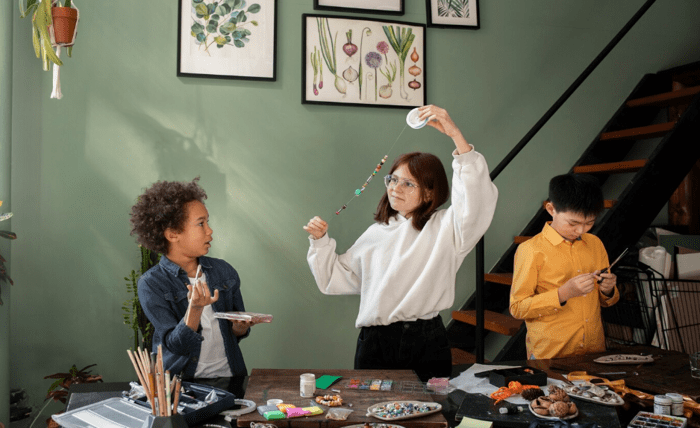
Fostering creativity in students goes beyond teaching them how to draw or paint. It’s about nurturing curiosity, encouraging risk-taking, and creating an environment where students feel safe expressing themselves. A well-rounded art program can inspire students to explore different perspectives and discover their unique voice through visual expression.
The Importance of Creative Thinking
In today’s world, where automation is rapidly replacing routine tasks, creative thinking remains a uniquely human strength. Art education plays a critical role in developing this skill. Students who engage in creative tasks learn to approach problems from various angles, adapt quickly, and remain open to new ideas—skills that serve them well beyond the classroom.
How Art Connects to Other Subjects
Art doesn’t exist in isolation. When integrated effectively, it connects with other disciplines like math, history, science, and language arts. Visual arts can enhance comprehension in geometry, storytelling, or even biology. This cross-disciplinary approach not only deepens understanding but also fosters excitement for learning.
Structuring an Engaging Art Curriculum
A thoughtfully structured curriculum ensures students build both technical skills and creative confidence over time. Balance is key—between structure and freedom, technique and intuition, individual and collaborative work.
Core Elements of a Strong Art Program
A successful curriculum includes:
- Foundational techniques such as color theory, shading, and composition
- Exposure to diverse media, from paint to collage to digital tools
- Art history integration, offering context and inspiration
- Assessment through portfolios, rather than tests alone
Encouraging Artistic Exploration
While technique is important, so is the freedom to explore. Encouraging students to experiment without fear of making mistakes fosters growth. Providing a variety of materials and prompts allows students to find their preferred mediums and styles.
Incorporating Technology in Art Education
Digital tools like tablets and design software are now essential parts of many art programs. They offer students new modes of expression and prepare them for modern creative industries. Even simple platforms like digital drawing apps can unlock unexpected enthusiasm and participation.
Creating the Right Environment for Artistic Expression
The physical space of an art classroom plays a major role in how students experience creativity. A well-designed environment invites inspiration, supports collaboration, and makes it easy for students to focus and create.
Visual Inspiration and Student Work
Displaying student artwork around the classroom instills pride and motivates others. Likewise, inspirational posters, color wheels, and art prints by diverse artists can encourage dialogue and curiosity. Rotating displays ensure the space always feels fresh and engaging.
Accessibility and Comfort
A successful art room layout considers lighting, ventilation, and seating arrangements. Natural light and flexible workstations can significantly improve student engagement. Comfortable, organized environments also help reduce stress and support focus—especially important for neurodiverse learners.
Material Organization and Safety
Clearly labeled storage bins, easy access to supplies, and safe usage instructions all contribute to a smooth workflow. Keeping sharp tools, adhesives, and pigments stored appropriately ensures safety while encouraging independent use.
Fostering Artistic Confidence and Growth
Art can be deeply personal, which makes it equally powerful and vulnerable. Teachers play a key role in helping students feel confident and supported in their artistic journey.
Giving Constructive Feedback
Rather than focusing on “right” or “wrong,” feedback should be framed around choices, technique, and intention. Open-ended questions like “What were you trying to express here?” or “How do you feel about this composition?” invite reflection and conversation.
Celebrating Progress, Not Just Talent
It’s essential to recognize effort and growth, not just final results. When students see their improvement over time, they’re more likely to remain motivated and less afraid of trying new things.
Including All Students
Art should feel inclusive, not exclusive. Offering a wide range of projects—from abstract collages to realistic portraits—can appeal to different personalities and strengths. This diversity ensures that each student has a chance to shine in their own way.
Quick List: Low-Cost Ways to Boost Creativity
Here are a few budget-friendly ideas to promote creativity in any art classroom:
- Art scavenger hunts – Find shapes, colors, or patterns around the room.
- Daily warm-up sketches – 5-minute prompts that jumpstart imagination.
- Collaborative murals – Large paper sheets where everyone contributes.
- Recycled art projects – Use cardboard, wrappers, or fabric scraps creatively.
- Art from music – Have students illustrate how a song makes them feel.
Quick List: Ways to Integrate Art Across the Curriculum
- Science – Sketch plant anatomy, build atom models, or explore optical illusions.
- Math – Teach symmetry, geometry, and ratios through perspective drawings.
- History – Recreate historical scenes or traditional art styles from specific eras.
- Language Arts – Illustrate poems, create character collages, or visual storyboards.
- Geography – Design maps, flags, or visual representations of cultures.
Why Quality Tools Still Matter
While creativity can thrive with minimal materials, having access to high-quality tools can greatly enrich the learning experience. Students can better explore technique and precision when using materials designed for professionals.
Professional-grade supplies—such as sketching pencils, fine brushes, and azure markers—help students achieve clean lines, vibrant color blends, and smooth shading. When students work with tools that feel professional, their confidence grows. It subtly communicates that their work is valued, and their ideas are worth expressing.
For classrooms looking to introduce advanced color work, especially in design or portfolio classes, azure markers offer both precision and depth—ideal for bold illustrations and detailed shading alike.
Final Thoughts
Art education is more than teaching students to replicate techniques—it’s about unlocking their ability to see the world differently. By combining structured guidance with open creative space, educators help shape resilient, thoughtful, and expressive individuals. Whether students pursue art professionally or not, the skills they develop—observation, empathy, critical thinking—will stay with them for life.
And with the right atmosphere, the right mindset, and access to inspiring materials, every art classroom can become a place where creativity thrives.




